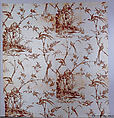Length
Probably Bromley Hall Printworks
Not on view
The rare design of this printed cotton reflects two trends prevalent in English decorative arts of the second half of the eighteenth century: the use of birds as decorative motifs, especially in ceramics and porcelains, and the continuing fascination with chinoiserie. Here thin, delicate branches, tied at intervals, rise from the earth and sprout elegantly whimsical blossoms and foliage of various types. Exotic birds are shown in flight or alighting on these slender stems. Two birds confront each other amid decorative rockery, while below four others scratch for food.
The inspiration for this design, with its elaborately feathered and crested birds and fanciful foliage, would seem to come not from the several ornithological studies printed in England during the eighteenth century, but rather from the influence of imported Chinese painted wallpapers. Highly unusual is the presence of three small Arabic numbers, 3 7 3, visible at the lower right edge of the groundline. Numbers are known to appear on impressions printed on paper and kept as records of the designs, but they are not normally found on the printed cottons themselves.
Stylistically the design bears similarities to other plate-printed textiles made at Bromley Hall, a printworks in Middlesex belonging to the Ollive, Talwin, and Foster families. The presence of three blue threads in the selvage provides further information as to place of origin and date; in 1774 a ban against textile printing on English-made cottons was rescinded with the proviso that three blue threads be woven into the selvages to identify the piece as of English manufacture.
Due to rights restrictions, this image cannot be enlarged, viewed at full screen, or downloaded.
This artwork is meant to be viewed from right to left. Scroll left to view more.




